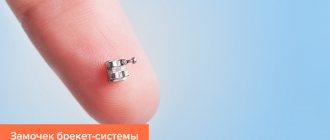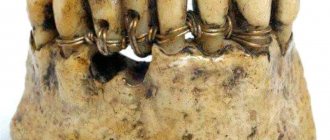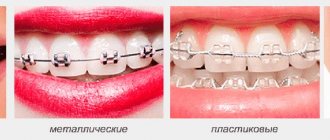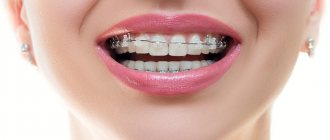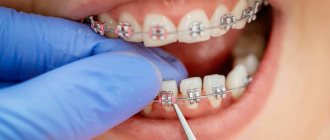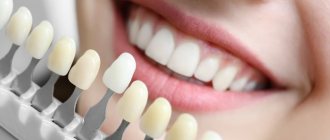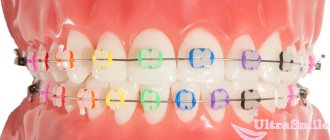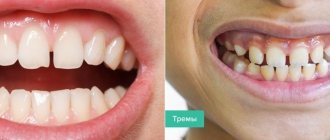- Pediatric orthodontics - correction of malocclusion in children
- Adult orthodontics - bite correction in adults
- Treatment with removable orthodontic appliances
- Correction of malocclusion without braces using mouthguards in adults.
- What orthodontic devices do our orthodontists use to correct the bite?
- How is braces treatment performed?
- What types of braces are there?
- How and why to choose an orthodontist?
- Reminder to the brace bearer
- What is orthognathy?
Everyone who was not given a beautiful smile and correct bite by nature wants to find them and get rid of insecurities, complexes and health problems forever.
But it is generally accepted that orthodontic treatment is long, painful and causes a lot of inconvenience. Today this is a misconception. Modern orthodontic technologies and bracket systems themselves differ significantly from previous ones. With proper preparation for orthodontic treatment and proper behavior of the patient, they provide sufficient comfort for the patient during the process. Read here about what you need for this.
Do teeth with braces hurt a lot and what can you do about it?
Fixing braces is a painless procedure. But after the orthodontic archwire is installed in the braces, pressure will be placed on the teeth. Therefore, for several days after installation and each new arch replacement, the teeth may ache a little.
How much your teeth will hurt depends on the characteristics of your body and its pain threshold. According to statistics, 10% of patients’ teeth do not hurt at all, more than half report minor pain, and only 5% of brace wearers report severe pain.
In any case, the discomfort goes away after a few days, and the orthodontist will advise which painkiller is best to take if the pain greatly ruins your life.
So putting on braces is not painful, but rather a little unpleasant. But for the sake of the beauty of your smile and your own health, you can endure a little.
Causes
Braces are considered a fragile structure, therefore, when using the product, the patient should follow certain rules and follow the recommendations of a specialist. This will maintain the integrity of the system throughout the entire treatment period.
The locks of the device are glued to a special adhesive. The adhesive has high strength values. It can withstand a certain pressure, but is destroyed when the force increases.
The power arc is deformed when the system is installed. She puts the main pressure on the locks, trying to return to their original state. With crowded teeth and some other malocclusions, uneven distribution of pressure occurs.
So, the fixation of the elements of an othodontic product can be impaired for several reasons. Among them:
- Consumption of inappropriate products. Doctors recommend excluding hard, tough and sticky foods from the diet.
- Inaccurate movements when performing hygienic procedures for caring for the oral cavity. You should use a toothbrush with soft bristles and use dental brushes carefully.
- Pathological arrangement of teeth. An acute lack of space creates significant pressure on the dentition. Conditions for element rejection arise even with the most minimal arc parameters.
The period of wearing braces ranges from one to three years. The duration of treatment depends on the age of the patient and the specific clinical case. The longer the correction, the higher the risk of structural failure.
How to get used to the braces system?
Any braces are a foreign body in the oral cavity. And in the first couple of weeks after their installation, the body will be uncomfortable with them. Then addiction will set in, and the braces system will no longer cause inconvenience.
During the habituation period, you may experience:
- increased salivation,
- impaired speech clarity,
- The braces system can rub the mucous membrane.
To reduce these negative effects to a minimum and quickly get used to braces, we recommend:
- Rinse your mouth with astringent solutions - decoctions of oak bark, shepherd's purse, drink tea with viburnum, water with lemon - this will help reduce saliva production.
- Practice pronunciation by speaking tongue twisters or simply reading aloud. This way your speech apparatus will quickly get used to the new working conditions.
- Use orthodontic wax to cover interfering clasps. Your orthodontist will give out the wax immediately after fixation. If the braces are rubbed and inflammation appears on the mucous membrane, use a healing ointment. In this case, Solcoseryl will work well.
- Always have a travel hygiene kit with you so you can brush your teeth immediately after eating.
Installation procedure
How are braces attached? To begin with, the orthodontist installs a special expander in the patient’s mouth, which will provide access to all teeth in the jaw and will prevent salivary fluid from entering the tooth enamel. After this, he begins to gradually treat all units with a composition containing a large amount of fluorine and other useful additives.
After this, orthodontic locks and rings are attached, and the brackets are fixed. Here the orthodontist works with the help of an assistant who applies an adhesive composition to the teeth. Next, the brackets themselves are installed. At the same time, for the convenience of the master, all elements are numbered. This process is painless and does not require the use of anesthetics. Duration of work – no more than 2 hours.
After installing the last bracket, the orthodontist carefully trims the remains of the arch along the edges and bends its ends, this is necessary in order to avoid accidental injury to the mucous membrane, lips and tongue. Some cases involve the installation of additional rubber bands or rods, which increase the arc pressure and enhance the overall effect of the system.
previous post
Is it possible to get a vaccination after dental implantation?
next entry
What can you eat with braces?
There are no big prohibitions on certain foods during orthodontic treatment, but it is better to adhere to the following rules:
- In the first days after installation and activation, while your teeth ache, it is better to eat soft and liquid food - porridge, puree soups, smoothies, yoghurts and curds. This will make it easier to get used to your new state.
- There is no need to eat sticky foods that can get stuck in the braces and damage them. And even if they don’t damage them, it’s difficult to clean them out later. Therefore, toffees, caramels, chewing gum, as well as cookies, baked goods, and other foods that become sticky when chewed are prohibited.
- Do not eat hard foods - crackers, nuts, pieces of meat, etc. — they can easily damage your braces. For the same reason, cut raw vegetables and fruits into small pieces.
- Don't forget that products such as tea, coffee, colored drinks, beets, blueberries, etc. may change the color of some types of braces and ligatures on them. And sitting in a cafe with a brace system full of, for example, red beets is not very aesthetically pleasing. So think about it.
- If your brace system has thermo-active orthodontic wires, then you cannot eat ice cream or drink ice water. The fact is that at ordinary temperatures a thermoactive arc can be given any shape. Then, under the influence of a person’s body temperature, it “remembers” the shape that was put into it during production and begins to work. And here you are with your ice cream...
Indications for replacement
There are two reasons for replacing the arc:
- Planned adjustments during treatment;
- Damage to the power element.
In the first case, the procedure ensures the maintenance of directed traction, under the influence of which the problematic units continue to move into their natural anatomical position. In some brace designs, the wire tension is changed using a screw element, however, each arch has a limit threshold, which is not always enough to complete the correction cycle.
The second situation is caused by the occurrence of mechanical defects that exclude the possibility of further operation of the structure. Such cases are extremely rare - modern techniques involve the use of high-strength materials, the likelihood of breakage of which is minimal.
It is worth noting that when replacing a power arc as part of a planned cycle, both the upper and lower elements are updated, whereas in the event of a breakdown, only the damaged part is replaced.
How to properly brush teeth with braces?
To care for your teeth while wearing braces, you will need a whole range of products:
- A suitable toothpaste should be recommended by your dentist.
- Special orthodontic toothbrush.
- Mono-tuft toothbrush.
- Interdental brushes of different diameters.
- A special dental floss for caring for braces is superfloss.
- Mouthwash.
- And, preferably, an irrigator.
You need to brush your teeth thoroughly twice a day - morning and evening, consistently using all the products from the list above. With toothbrushes you need to make sweeping movements, first on the lateral sections of the dentition - from the outside and from the inside, and then in the front. Using dental brushes and floss, it is necessary to thoroughly clean the interdental spaces, areas under the arch and next to the braces. At the end of hygiene, you need to rinse your mouth with mouthwash or use an irrigator.
During orthodontic treatment, patients need to carry a special travel dental hygiene kit with them in order to always be able to get their teeth in order with braces. After each meal, remove all food debris from the braces system.
In addition to daily home hygiene, once every 4-6 months, patients with braces need to undergo a professional hygiene procedure in the clinic.
Immediately after fixing the braces system, the orthodontist will teach the patient how to properly care for their teeth during treatment.
Remember, it is not braces that spoil your teeth! It is poorly cleaned plaque that causes demineralization and then caries.
Duration of treatment and frequency of revisions
The use of braces is the most effective way to eliminate dental defects. Orthodontic treatment provides a number of benefits:
- Restoration of correct bite;
- Predictability of treatment outcomes;
- Wide selection of corrective designs;
- Aesthetics of the models used;
- No need for additional treatment.
The factor determining the duration of treatment is the specificity of the diagnosed pathology, and in each case the medical prognosis will be based on the clinical picture. However, what is common to all patients is the presence of a schedule of visits to the dental clinic, according to which it will be necessary to check in with the orthodontist.
Wire arches, fixed in brackets attached to the teeth, create the necessary level of pressure, forcing the problem units to move in a given direction. At the first stage of orthodontic treatment, it is recommended to install less rigid elements, the task of which is to gradually prepare the jaw region for upcoming changes. Over time, the stiffness coefficient increases, which helps correct the bite and straighten the teeth.
Each visit during the correction phase involves two procedures: an assessment of the current dynamics of recovery, as well as making changes to the design settings that ensure the greatest effectiveness of the impact. Standard practice involves replacing the arch wire at least three to four times, and in complex cases at intervals determined within the treatment plan.
How to wear orthodontic traction bands - elastics?
Orthodontic rods - elastics - are special latex “rubber bands” that are placed on the hooks of the braces system to tighten the jaws together. They greatly increase the effectiveness of braces treatment. Properly selected and worn elastics do not interfere with speaking. The main rule of wearing pull-ups is regularity.
The time to start wearing elastics, their type and the pattern according to which the rods are put on the brace system is prescribed ONLY by the orthodontist. Wearing elastics on your own can only cause harm. Also, the orthodontist puts orthodontic rods on the patient’s brace system for the first time and teaches him to do it independently. In order not to forget the location of the rods, it is convenient to photograph the diagram and then carefully repeat it - it is not at all difficult.
Why is this dangerous?
The loss of just one lock disrupts the planned operation of the entire orthodontic structure. The process of bite correction not only stops, but becomes completely uncontrollable.
The pressure on the teeth begins to be distributed incorrectly, and the clearly calculated trajectory of their movement changes. A correct bite cannot be formed under such conditions, and the consequences of treatment will become unpredictable. Correction of the defect can only be entrusted to the attending physician. Moreover, you need to seek help as quickly as possible, otherwise the answer to the question “ How long should you wear braces ?” the patient will not be happy at all.
What to do if the bracket comes off or the arch in the bracket system breaks?
Every brace wearer has at least once encountered the breakdown of elements of the brace system. You need to take this calmly, but you should return everything to its place as quickly as possible. A broken brace system not only does not correct your bite, it can cause serious harm.
So, in case of any force majeure with your braces system, call your orthodontist and make an appointment for the next few days.
What you can do yourself in various cases of brace system failure:
1. If the bracket comes off.
If the lock has only come off a little and has not completely fallen off the tooth, cover it together with the arch with a piece of orthodontic wax.
If the bracket has come off completely and is “hanging” on the arch, try using tweezers to remove the ligature or open the bracket cover to remove the lock from the orthodontic arch. Don’t forget to bring it to the orthodontist later - perhaps he will not change the lock, but will glue the old one in its place.
2. The orthodontic arch has jumped out of the bracket slot.
You can try to bring it back yourself using eyebrow tweezers. It is convenient to close the cover of a self-ligating bracket with a pencil with an elastic band at the end. If it doesn’t work out, it’s okay, but don’t put off visiting the orthodontist, because... in this situation, one tooth “fell out” of the treatment program, and this is bad.
3. When the orthodontic arch leaves the groove of the last bracket, it can injure the buccal mucosa. Try to carefully insert it back. If this does not work, then trim the free piece with nail clippers. Be careful not to swallow what you cut off! Cover the sharp end of the archwire with orthodontic wax or a cotton ball. This way you won't get hurt while getting to the orthodontist.
Construction of braces: comparison of non-ligating and self-ligating structures
There are ligature and self-ligating devices. The first includes traditional designs: the arc is fixed in the groove using elastic or wire ligatures. Example: Mini Diamond, Inspire Ice, Orthos devices. Ligature systems are characterized by a long treatment period - from one to three years, depending on the complexity of the clinical case, lengthy adaptation and labor-intensive hygienic care. Activate the device: replace arches and ligatures, it is necessary on average once a month, and sometimes more often.
traditional construction with ligatures
ligature Mini Diamond
The design of self-ligating braces has a fundamental difference: the system works without ligatures. Consists of a groove and a closing lid. The orthodontic arch slides in the groove. Ligature-free designs provide a reduction in treatment time compared to ligature devices by an average of 7 months. Less painful during the adaptation stage and easier from the point of view of oral hygiene. They turn out to be the option of choice in many clinical cases. The entire line of Damon System braces are self-ligating.
self-ligating Damon Q2
How does a braces system without ligatures work? The principle of operation of non-ligation devices is divided into passive and active self-ligation. With the passive type of fixation, the arc moves freely in the groove. The cover holds the arc and does not put pressure on it. Example: Damon Q, Damon Clear. With the active type of self-ligation, the clip presses on the arch and moves it to the base of the groove. Activation of self-ligating systems is carried out once every 2-3 months.
system without ligatures
Damon Clear and Q on typodont
Braces are made from various materials. Ligature and self-ligating structures are made of metal, transparent polycrystalline aluminum (ceramics), plastic and artificially grown sapphire. Metal braces, for example, Damon Q and Damon 3 MX, are the most durable. The Damon Clear2 ceramic and sapphire Inspire Ice models have the best aesthetic characteristics.
metal Damon Q2
ceramic Damon Clear
The orthodontist and the patient jointly overcome the path to high aesthetic smiles and a healthy dental system. Regardless of the type of braces and manufacturing material, the combination of the orthodontist’s professionalism with a high degree of patient responsibility allows one to achieve stable results in the treatment of malocclusions.
